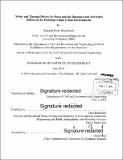| dc.contributor.advisor | Dara Entekhabi. | en_US |
| dc.contributor.author | Magnusson, Sigurður Pétur | en_US |
| dc.contributor.other | Massachusetts Institute of Technology. Department of Civil and Environmental Engineering. | en_US |
| dc.date.accessioned | 2014-09-19T21:36:27Z | |
| dc.date.available | 2014-09-19T21:36:27Z | |
| dc.date.copyright | 2014 | en_US |
| dc.date.issued | 2014 | en_US |
| dc.identifier.uri | http://hdl.handle.net/1721.1/90045 | |
| dc.description | Thesis: Ph. D., Massachusetts Institute of Technology, Department of Civil and Environmental Engineering, 2014. | en_US |
| dc.description | Cataloged from PDF version of thesis. | en_US |
| dc.description | Includes bibliographical references (pages 167-177). | en_US |
| dc.description.abstract | Human exposure to air pollutants and thermal stress in urban areas are public health concerns. The year 2008 was the first year when more than half of the human population lived in urban areas. Studies of the urban air fluid dynamics can be applied to increase pedestrian comfort and emergency response planning. In this study we focus on thermal effects on urban air flows. The thermal effects are extended beyond what is found in the literature to better understand the thermo fluid processes within urban areas. A field experiment on the air flow within an urban street canyon was performed to examine the relationship between the dimensionless in-canyon velocity, u/U₀, where U₀ is the free stream velocity, and the thermal conditions inside the canyon. A buoyancy parameter, B, which estimates the ratio between buoyancy forced and mechanically forced flows, is applied. The results indicate a mechanically driven flow regime for B parameters less than 0.05-0.1 (u/U₀ a constant). For larger B parameters, u/U₀ begins to increase and the flow is considered to be in the intermediate flow regime. To further extend the buoyancy effects, computational fluid dynamics (CFD) simulations are performed. The aspect ratio (H/L, H height of the buildings and L the width between the buildings) is varied. The results show that the air flow within urban areas can be considered to be purely buoyancy driven when the B parameter is larger than about 50. For canyons with aspect ratios near unity, u/U₀ ~~ B¹/² . The buoyancy is more important in deep canyons. The exchange rate between urban areas and the ambient air is an important factor in determining the human exposure to air pollutants. CFD simulations are developed to estimate the effects of increased buoyancy on the exchange rate and the results show how the exchange rate increases roughly with B¹/² for purely buoyancy driven flows. Finally, CFD simulations are performed to estimate the effects of horizontal advection on the air quality within urban areas. Under mechanically driven situations the concentration increases roughly by n¹/⁴ in the downstream direction, where n is the number of upstream canyons and the same amount of tracer is released inside each of the canyons. | en_US |
| dc.description.statementofresponsibility | by Sigurdur Petur Magnusson. | en_US |
| dc.format.extent | 177 pages | en_US |
| dc.language.iso | eng | en_US |
| dc.publisher | Massachusetts Institute of Technology | en_US |
| dc.rights | M.I.T. theses are protected by copyright. They may be viewed from this source for any purpose, but reproduction or distribution in any format is prohibited without written permission. See provided URL for inquiries about permission. | en_US |
| dc.rights.uri | http://dspace.mit.edu/handle/1721.1/7582 | en_US |
| dc.subject | Civil and Environmental Engineering. | en_US |
| dc.title | Wind- and thermal-driven air flows and the buoyancy and advection effects on air exchange within urban environments | en_US |
| dc.type | Thesis | en_US |
| dc.description.degree | Ph. D. | en_US |
| dc.contributor.department | Massachusetts Institute of Technology. Department of Civil and Environmental Engineering | |
| dc.identifier.oclc | 890139770 | en_US |
